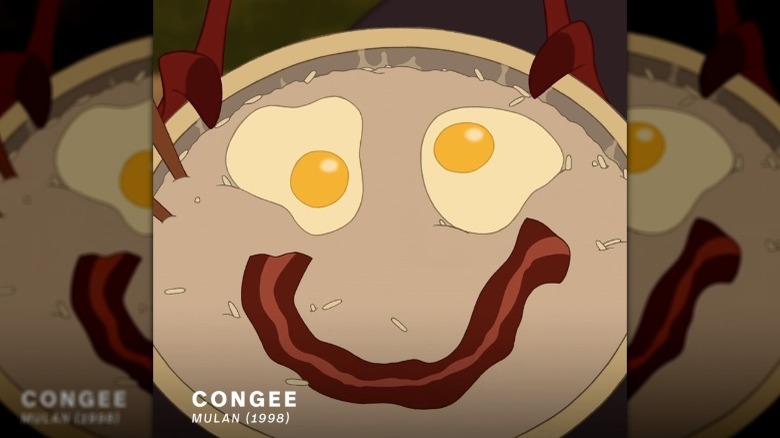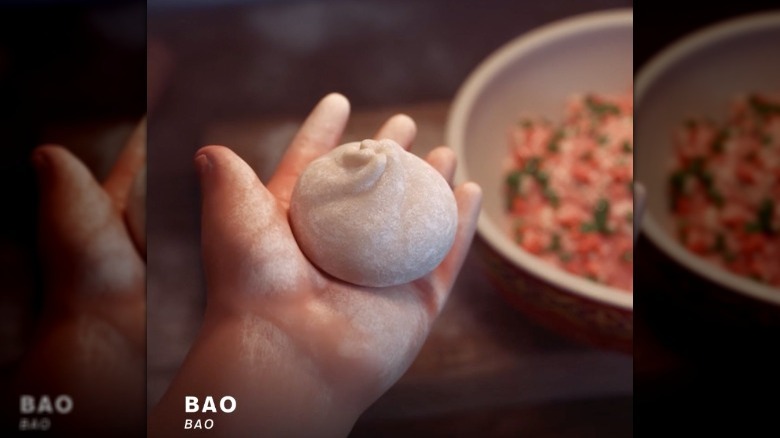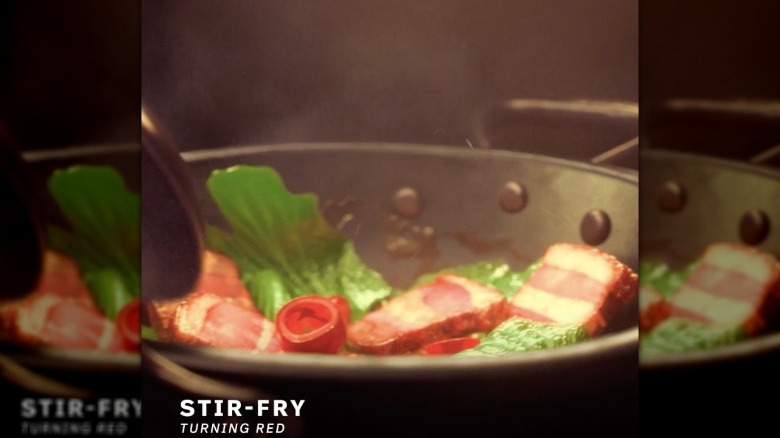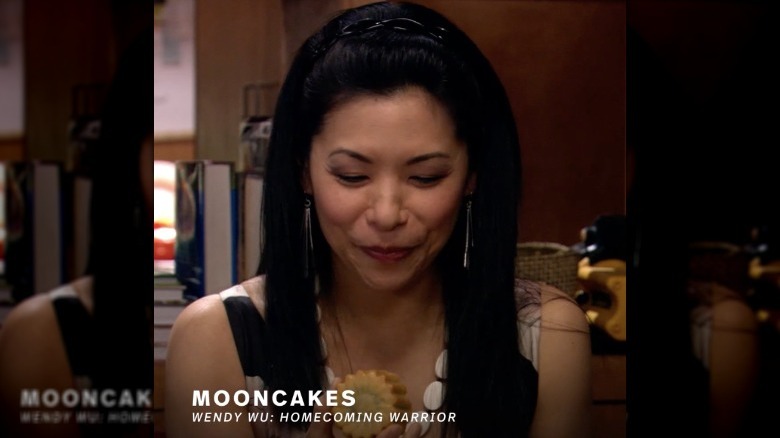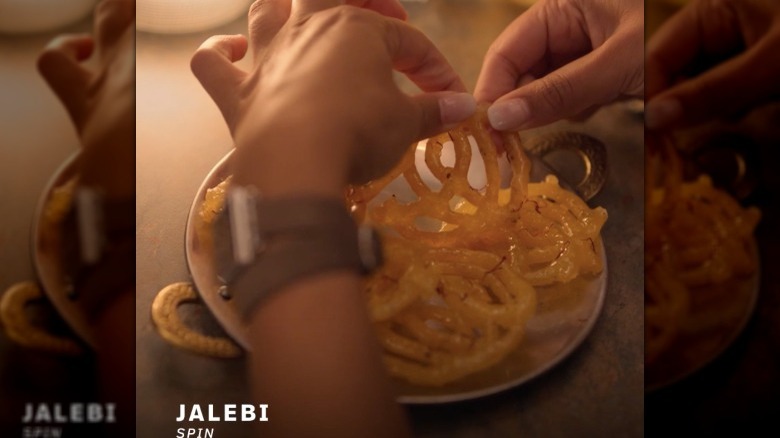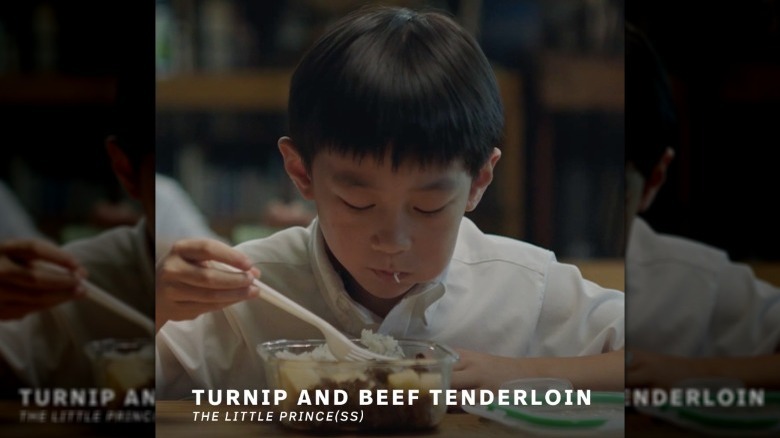Disney+ Is Celebrating AAPI Heritage Month With So Many Delicious On-Screen Foods
As AAPI Heritage Month comes to a close, Disney+ is honoring Asian Americans and Pacific Islanders with a collection of still images from its movies and shows on the Disney+ platform that centers around foods enjoyed by characters representing AAPI cultures. As viewers find in these movies and shows, food often plays an integral part in connecting and keeping together communities and families (via a press release obtained by Mashed).
In "Raya and the Last Dragon," for example, Raya's father attempts to unite the factions of a kingdom by bringing them all together for a meal for which they all contributed an ingredient, while in "Wendy Wu: Homecoming Warrior," Wendy's father is reminded of the importance of maintaining and passing on his Chinese heritage when given a mooncake by an older relative.
In "Spin," a new fan learns of the joys of Indian pastries, while in "Mira, Royal Detective," a young girl shares her knowledge of Indian food with other children. From "Mulan" to "Bao" to "Turning Red" to "The Little Prince(ss)," food plays an important role in revealing cultures that are certainly worth celebrating not only this month but every month of the year.
Mulan: Congee
Who can forget when the adorable dragon Mushu wakes up Mulan on her first day in the Chinese army's training camp with a steaming bowl of congee topped with bacon and eggs in the shape of a smiley face? Mushu offers the bowl displaying a goofy smile made from a slice of bacon and googly eyes made from two over-easy eggs (via GMA Entertainment). "Look, you get porridge, and it's happy to see you!" Mushu told her. Mushu then feeds the congee to Mulan while offering advice for the day, including telling her to put on her "war face."
WDW Magazine explains that congee is a Chinese porridge made from rice and details a recipe that calls for just a few simple ingredients: long-grain white rice, water — or a broth of your choosing — and a bit of salt to make the porridge — and, of course, the eggs and bacon to make the smiley face! You can also dress up your congee by adding garlic and/or ginger, peanuts, or another protein like chicken.
Bao: Bao
The Disney Pixar short film "Bao" features a Chinese woman whose motherly instincts are ignited when one of the bao she is preparing transforms into a bao-child, springing to life and laughing as she holds it. The film follows the pair's relationship as the bao-boy gets bigger and all the growing pains that come along with an evolving mother-son relationship. As viewers, we not only have an opportunity to see how bao are prepared, from rolling the dough to creating the stuffing to steaming the bao, but also familial dynamics that are universal across cultures (via Pixar).
Even while animated, the bao the mother makes in the film look pretty tasty. School of Wok states that bao are "a delicious, warm, fluffy treat of stuffing wrapped inside a sweet, white dough" that are then steamed, creating a finished product that's a bit sweeter than a dumpling and is ideally "light, round, and soft." It's easy to make mistakes when cooking dumplings, but with some patience, you'll have perfect dough babies in no time!
Raya and the Last Dragon: Kumandra Soup/Tom Yum
According to Radio Times, "Raya and the Last Dragon" is Disney's first film focusing on Southeast Asian culture, and it does so in a way that draws on the importance of the food in said culture. In the movie, food is symbolic of the forces that bring us together, as can be seen in the Kumandra soup, Raya's father Benja's form of Tom Yum soup, which is made from ingredients from each of the kingdom's five lands and was made to share among their leaders. Leading voice actor Kelly Marie Tran noted the role food plays in the movie, stating, "Food is, I think, the one thing that can bring everyone together" (via YouTube).
Disney shared a Kumandra-inspired Tom Yum soup recipe from renowned Asian chef Adam Liaw, which is made with prawns, lemongrass, lime leaves, chili paste, and a variety of vegetables, among other ingredients. Just be sure to keep in mind the difference between prawns and shrimp when purchasing ingredients for this dish. "One of the best messages of the film is how food can bring people together despite their differences," Liaw wrote of the recipe on Instagram.
Turning Red: Pork and Lettuce Stir Fry
"Turning Red" follows the coming of age story of Chinese Canadian teenager Mei Lee. Various foods are prepared in the film, including bao and congee, but, perhaps most famously, Mei's father prepares a pork and lettuce stir fry. If you found yourself inspired by the food in the film, you're in luck, because Weee, an "ethnic e-grocer" partnered with Pixar to create the three recipes and make them available to the public, as well as to sell all the necessary ingredients to make them (via Winsight Grocery Business).
"Turning Red's" production designer, Rona Liu, chatted with Eater, too, about how the production team worked to make the food look so vibrant in the film, specifically noting the pork and lettuce stir fry, which Liu said was one of the most difficult foods to represent given that the ingredients change color and texture quickly when cooked. As far as viewer reactions go, Liu said the response has been positive. "Everybody at some point has said something about the food looking delicious," Liu said.
Wendy Wu: Homecoming Warrior: Mooncake
"Wendy Wu: Homecoming Warrior" is a 2006 Disney Channel movie that tells the story of Wendy Wu, a Chinese American teenager too busy concentrating on running for homecoming queen to be bothered with the fact that she has been tasked with saving the world (via IMDb). In the movie, Wendy's father is given mooncakes by Shen, a "long-lost relative," which cause him to reconsider his cultural heritage and how he wants to incorporate his family's Chinese identity with its American identity (via YouTube).
In addition to their sometimes fancy appearance and apparent deliciousness, mooncakes are part of a rich cultural history. Originally made as offerings to the moon, they now are made and consumed during China's Mid-Autumn Festival to celebrate the "completeness and togetherness" symbolized by the full moon. Different areas of China prepare mooncakes differently; in Beijing, they tend to be more ornate, while Cantonese-style mooncakes are usually sweeter. Fillings might include red beans, ice cream, green tea, or lotus seed paste (via China Highlights).
Spin: Jalebi
At first glance, the Disney Channel movie "Spin" is about the main character Rhea and her connection to her Indian culture through music; however, there's another force at play in the film: food. Rhea's family owns an Indian restaurant that Fansided calls a character in and of itself. In fact, the outlet calls it "the character that brings everyone together." At one point in the movie, Rhea's teacher and her father find themselves in a debate over which is the better pastry: donuts or Indian jalebis, a spiral-shaped maida-flour-based fried treats that has been soaked in sweet syrup.
Preparation styles for jalebis can vary. Bon Appétit suggests a jalebi recipe that calls for a cardamom-rose syrup but notes that you could also use orange flower water or any other kind of spices you wish. One recipe reviewer noted, "This recipe was easy to follow and yielded tasty results ... They felt like the ones I'd eaten on the streets of New Delhi!"
Mira, Royal Detective: Coconut Ladoos
Mira is a pint-sized detective assigned to protect Indian royalty alongside her two animal sidekicks in "Mira, Royal Detective," which airs on Disney Junior (via IMDb). One such case the trio tackles is the case of samosa and the ladoo in which young viewers learn all about these two unique Indian foods. "Ladoos are usually made with butter, flour, sugar, and sometimes nuts. This is the perfect snack for all kinds of celebrations like birthdays and holidays. You can celebrate any special day with a ladoo," Mira tells viewers in one episode.
One popular type of ladoo is coconut ladoo. Priya Lakshminarayan, blogger and recipe developer at Cookilicious, put together a vegan coconut ladoo recipe that takes only 15 minutes to prepare and calls for just a few simple ingredients: coconut flakes, coconut milk, coconut oil, almond powder, sugar, cardamom, and chopped nuts. Mira would be proud!
The Little Prince(ss): Turnip and Beef Tenderloin
"The Little Prince(ss)" is about the friendship between two young Chinese boys — Gabriel and Rob — who meet on the school bus and encourage each other to be the best, most genuine versions of themselves, no matter what others, including Rob's father, might think (via IMDb).
In the film, one of the meals eaten is turnip and beef tenderloin served with white rice. Chinese turnips, which Livestrong notes are also known as jicama and are different from Daikon radishes, are crispy, textured, and very healthy for you. While they are popularly used shredded as an ingredient in turnip cake, they can also be diced and cooked with marinated meat, such as beef tenderloin. A similar recipe from food blogger and recipe developer Tracy Omae, who spent part of her childhood in China, combines braised beef with radish and a sauce of oyster sauce and soy sauce to create this Cantonese-style dish (via Oh My Food Recipes).

